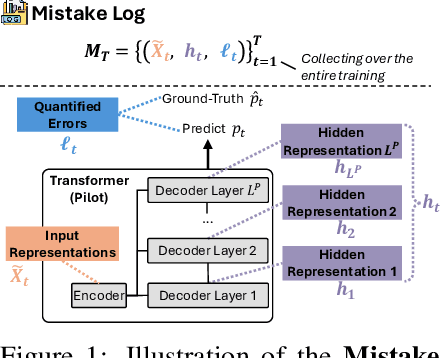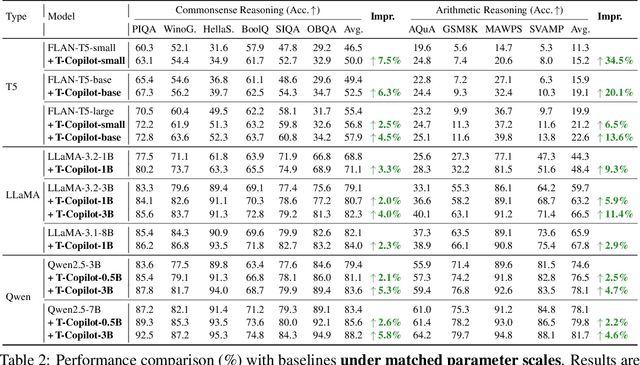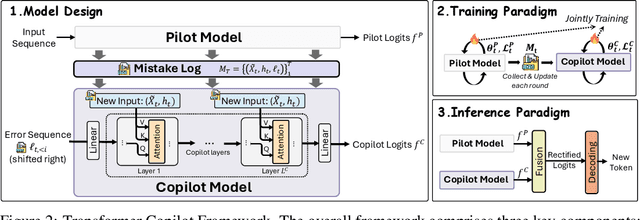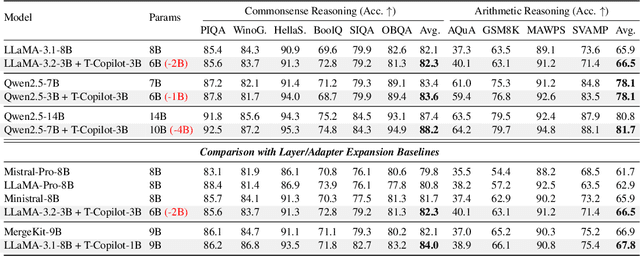Jingrui He
NIRVANA: Structured pruning reimagined for large language models compression
Sep 17, 2025Abstract:Structured pruning of large language models (LLMs) offers substantial efficiency improvements by removing entire hidden units, yet current approaches often suffer from significant performance degradation, particularly in zero-shot settings, and necessitate costly recovery techniques such as supervised fine-tuning (SFT) or adapter insertion. To address these critical shortcomings, we introduce NIRVANA, a novel pruning method explicitly designed to balance immediate zero-shot accuracy preservation with robust fine-tuning capability. Leveraging a first-order saliency criterion derived from the Neural Tangent Kernel under Adam optimization dynamics, NIRVANA provides a theoretically grounded pruning strategy that respects essential model training behaviors. To further address the unique challenges posed by structured pruning, NIRVANA incorporates an adaptive sparsity allocation mechanism across layers and modules (attention vs. MLP), which adjusts pruning intensity between modules in a globally balanced manner. Additionally, to mitigate the high sensitivity of pruning decisions to calibration data quality, we propose a simple yet effective KL divergence-based calibration data selection strategy, ensuring more reliable and task-agnostic pruning outcomes. Comprehensive experiments conducted on Llama3, Qwen, and T5 models demonstrate that NIRVANA outperforms existing structured pruning methods under equivalent sparsity constraints, providing a theoretically sound and practical approach to LLM compression. The code is available at https://github.com/iDEA-iSAIL-Lab-UIUC/NIRVANA.
Flow Matching Meets Biology and Life Science: A Survey
Jul 23, 2025Abstract:Over the past decade, advances in generative modeling, such as generative adversarial networks, masked autoencoders, and diffusion models, have significantly transformed biological research and discovery, enabling breakthroughs in molecule design, protein generation, drug discovery, and beyond. At the same time, biological applications have served as valuable testbeds for evaluating the capabilities of generative models. Recently, flow matching has emerged as a powerful and efficient alternative to diffusion-based generative modeling, with growing interest in its application to problems in biology and life sciences. This paper presents the first comprehensive survey of recent developments in flow matching and its applications in biological domains. We begin by systematically reviewing the foundations and variants of flow matching, and then categorize its applications into three major areas: biological sequence modeling, molecule generation and design, and peptide and protein generation. For each, we provide an in-depth review of recent progress. We also summarize commonly used datasets and software tools, and conclude with a discussion of potential future directions. The corresponding curated resources are available at https://github.com/Violet24K/Awesome-Flow-Matching-Meets-Biology.
ReasonFlux-PRM: Trajectory-Aware PRMs for Long Chain-of-Thought Reasoning in LLMs
Jun 23, 2025



Abstract:Process Reward Models (PRMs) have recently emerged as a powerful framework for supervising intermediate reasoning steps in large language models (LLMs). Previous PRMs are primarily trained on model final output responses and struggle to evaluate intermediate thinking trajectories robustly, especially in the emerging setting of trajectory-response outputs generated by frontier reasoning models like Deepseek-R1. In this work, we introduce ReasonFlux-PRM, a novel trajectory-aware PRM explicitly designed to evaluate the trajectory-response type of reasoning traces. ReasonFlux-PRM incorporates both step-level and trajectory-level supervision, enabling fine-grained reward assignment aligned with structured chain-of-thought data. We adapt ReasonFlux-PRM to support reward supervision under both offline and online settings, including (i) selecting high-quality model distillation data for downstream supervised fine-tuning of smaller models, (ii) providing dense process-level rewards for policy optimization during reinforcement learning, and (iii) enabling reward-guided Best-of-N test-time scaling. Empirical results on challenging downstream benchmarks such as AIME, MATH500, and GPQA-Diamond demonstrate that ReasonFlux-PRM-7B selects higher quality data than strong PRMs (e.g., Qwen2.5-Math-PRM-72B) and human-curated baselines. Furthermore, our derived ReasonFlux-PRM-7B yields consistent performance improvements, achieving average gains of 12.1% in supervised fine-tuning, 4.5% in reinforcement learning, and 6.3% in test-time scaling. We also release our efficient ReasonFlux-PRM-1.5B for resource-constrained applications and edge deployment. Projects: https://github.com/Gen-Verse/ReasonFlux
Learnable Spatial-Temporal Positional Encoding for Link Prediction
Jun 11, 2025Abstract:Accurate predictions rely on the expressiveness power of graph deep learning frameworks like graph neural networks and graph transformers, where a positional encoding mechanism has become much more indispensable in recent state-of-the-art works to record the canonical position information. However, the current positional encoding is limited in three aspects: (1) most positional encoding methods use pre-defined, and fixed functions, which are inadequate to adapt to the complex attributed graphs; (2) a few pioneering works proposed the learnable positional encoding but are still limited to the structural information, not considering the real-world time-evolving topological and feature information; (3) most positional encoding methods are equipped with transformers' attention mechanism to fully leverage their capabilities, where the dense or relational attention is often unaffordable on large-scale structured data. Hence, we aim to develop Learnable Spatial-Temporal Positional Encoding in an effective and efficient manner and propose a simple temporal link prediction model named L-STEP. Briefly, for L-STEP, we (1) prove the proposed positional learning scheme can preserve the graph property from the spatial-temporal spectral viewpoint, (2) verify that MLPs can fully exploit the expressiveness and reach transformers' performance on that encoding, (3) change different initial positional encoding inputs to show robustness, (4) analyze the theoretical complexity and obtain less empirical running time than SOTA, and (5) demonstrate its temporal link prediction out-performance on 13 classic datasets and with 10 algorithms in both transductive and inductive settings using 3 different sampling strategies. Also, L-STEP obtains the leading performance in the newest large-scale TGB benchmark. Our code is available at https://github.com/kthrn22/L-STEP.
Saffron-1: Towards an Inference Scaling Paradigm for LLM Safety Assurance
Jun 06, 2025Abstract:Existing safety assurance research has primarily focused on training-phase alignment to instill safe behaviors into LLMs. However, recent studies have exposed these methods' susceptibility to diverse jailbreak attacks. Concurrently, inference scaling has significantly advanced LLM reasoning capabilities but remains unexplored in the context of safety assurance. Addressing this gap, our work pioneers inference scaling for robust and effective LLM safety against emerging threats. We reveal that conventional inference scaling techniques, despite their success in reasoning tasks, perform poorly in safety contexts, even falling short of basic approaches like Best-of-N Sampling. We attribute this inefficiency to a newly identified challenge, the exploration--efficiency dilemma, arising from the high computational overhead associated with frequent process reward model (PRM) evaluations. To overcome this dilemma, we propose SAFFRON, a novel inference scaling paradigm tailored explicitly for safety assurance. Central to our approach is the introduction of a multifurcation reward model (MRM) that significantly reduces the required number of reward model evaluations. To operationalize this paradigm, we further propose: (i) a partial supervision training objective for MRM, (ii) a conservative exploration constraint to prevent out-of-distribution explorations, and (iii) a Trie-based key--value caching strategy that facilitates cache sharing across sequences during tree search. Extensive experiments validate the effectiveness of our method. Additionally, we publicly release our trained multifurcation reward model (Saffron-1) and the accompanying token-level safety reward dataset (Safety4M) to accelerate future research in LLM safety. Our code, model, and data are publicly available at https://github.com/q-rz/saffron , and our project homepage is at https://q-rz.github.io/p/saffron .
Invariant Link Selector for Spatial-Temporal Out-of-Distribution Problem
May 30, 2025Abstract:In the era of foundation models, Out-of- Distribution (OOD) problems, i.e., the data discrepancy between the training environments and testing environments, hinder AI generalization. Further, relational data like graphs disobeying the Independent and Identically Distributed (IID) condition makes the problem more challenging, especially much harder when it is associated with time. Motivated by this, to realize the robust invariant learning over temporal graphs, we want to investigate what components in temporal graphs are most invariant and representative with respect to labels. With the Information Bottleneck (IB) method, we propose an error-bounded Invariant Link Selector that can distinguish invariant components and variant components during the training process to make the deep learning model generalizable for different testing scenarios. Besides deriving a series of rigorous generalizable optimization functions, we also equip the training with task-specific loss functions, e.g., temporal link prediction, to make pretrained models solve real-world application tasks like citation recommendation and merchandise recommendation, as demonstrated in our experiments with state-of-the-art (SOTA) methods. Our code is available at https://github.com/kthrn22/OOD-Linker.
Breaking Silos: Adaptive Model Fusion Unlocks Better Time Series Forecasting
May 24, 2025Abstract:Time-series forecasting plays a critical role in many real-world applications. Although increasingly powerful models have been developed and achieved superior results on benchmark datasets, through a fine-grained sample-level inspection, we find that (i) no single model consistently outperforms others across different test samples, but instead (ii) each model excels in specific cases. These findings prompt us to explore how to adaptively leverage the distinct strengths of various forecasting models for different samples. We introduce TimeFuse, a framework for collective time-series forecasting with sample-level adaptive fusion of heterogeneous models. TimeFuse utilizes meta-features to characterize input time series and trains a learnable fusor to predict optimal model fusion weights for any given input. The fusor can leverage samples from diverse datasets for joint training, allowing it to adapt to a wide variety of temporal patterns and thus generalize to new inputs, even from unseen datasets. Extensive experiments demonstrate the effectiveness of TimeFuse in various long-/short-term forecasting tasks, achieving near-universal improvement over the state-of-the-art individual models. Code is available at https://github.com/ZhiningLiu1998/TimeFuse.
CLIMB: Class-imbalanced Learning Benchmark on Tabular Data
May 23, 2025Abstract:Class-imbalanced learning (CIL) on tabular data is important in many real-world applications where the minority class holds the critical but rare outcomes. In this paper, we present CLIMB, a comprehensive benchmark for class-imbalanced learning on tabular data. CLIMB includes 73 real-world datasets across diverse domains and imbalance levels, along with unified implementations of 29 representative CIL algorithms. Built on a high-quality open-source Python package with unified API designs, detailed documentation, and rigorous code quality controls, CLIMB supports easy implementation and comparison between different CIL algorithms. Through extensive experiments, we provide practical insights on method accuracy and efficiency, highlighting the limitations of naive rebalancing, the effectiveness of ensembles, and the importance of data quality. Our code, documentation, and examples are available at https://github.com/ZhiningLiu1998/imbalanced-ensemble.
Transformer Copilot: Learning from The Mistake Log in LLM Fine-tuning
May 22, 2025



Abstract:Large language models are typically adapted to downstream tasks through supervised fine-tuning on domain-specific data. While standard fine-tuning focuses on minimizing generation loss to optimize model parameters, we take a deeper step by retaining and leveraging the model's own learning signals, analogous to how human learners reflect on past mistakes to improve future performance. We first introduce the concept of Mistake Log to systematically track the model's learning behavior and recurring errors throughout fine-tuning. Treating the original transformer-based model as the Pilot, we correspondingly design a Copilot model to refine the Pilot's inference performance via logits rectification. We name the overall Pilot-Copilot framework the Transformer Copilot, which introduces (i) a novel Copilot model design, (ii) a joint training paradigm where the Copilot continuously learns from the evolving Mistake Log alongside the Pilot, and (iii) a fused inference paradigm where the Copilot rectifies the Pilot's logits for enhanced generation. We provide both theoretical and empirical analyses on our new learning framework. Experiments on 12 benchmarks spanning commonsense, arithmetic, and recommendation tasks demonstrate that Transformer Copilot consistently improves performance by up to 34.5%, while introducing marginal computational overhead to Pilot models and exhibiting strong scalability and transferability.
My Emotion on your face: The use of Facial Keypoint Detection to preserve Emotions in Latent Space Editing
May 09, 2025Abstract:Generative Adversarial Network approaches such as StyleGAN/2 provide two key benefits: the ability to generate photo-realistic face images and possessing a semantically structured latent space from which these images are created. Many approaches have emerged for editing images derived from vectors in the latent space of a pre-trained StyleGAN/2 models by identifying semantically meaningful directions (e.g., gender or age) in the latent space. By moving the vector in a specific direction, the ideal result would only change the target feature while preserving all the other features. Providing an ideal data augmentation approach for gesture research as it could be used to generate numerous image variations whilst keeping the facial expressions intact. However, entanglement issues, where changing one feature inevitably affects other features, impacts the ability to preserve facial expressions. To address this, we propose the use of an addition to the loss function of a Facial Keypoint Detection model to restrict changes to the facial expressions. Building on top of an existing model, adding the proposed Human Face Landmark Detection (HFLD) loss, provided by a pre-trained Facial Keypoint Detection model, to the original loss function. We quantitatively and qualitatively evaluate the existing and our extended model, showing the effectiveness of our approach in addressing the entanglement issue and maintaining the facial expression. Our approach achieves up to 49% reduction in the change of emotion in our experiments. Moreover, we show the benefit of our approach by comparing with state-of-the-art models. By increasing the ability to preserve the facial gesture and expression during facial transformation, we present a way to create human face images with fixed expression but different appearances, making it a reliable data augmentation approach for Facial Gesture and Expression research.
 Add to Chrome
Add to Chrome Add to Firefox
Add to Firefox Add to Edge
Add to Edge